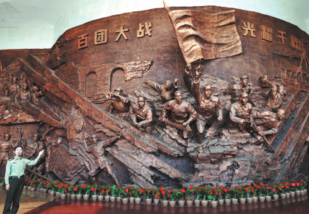Memorial hall helps foster spirit of revolution

Eighty-five years ago, in the heart of North China, in what is now Yangquan in Shanxi province, was the epicenter of one of the most significant campaigns in the Chinese People's War of Resistance Against Japanese Aggression (1931-45).
Known as the Hundred Regiments Offensive, the campaign was a bold and unprecedented counterattack by the Eighth Route Army, led by the Community Party of China, that not only disrupted enemy operations but galvanized national morale during the darkest days of World War II.
Launched on the night of Aug 20, 1940, the operation involved an astonishing 105 regiments — hence its later name — and continued for over five months, ending in January 1941.
Over the course of 1,824 engagements, the offensive inflicted more than 20,000 Japanese casualties. It was the largest and longest strategic offensive carried out by the Eighth Route Army in North China during the war.
"This battle was originally focused on sabotaging the Zhengding-Taiyuan Railway, but the scale quickly expanded," says Li Qi, a docent at the Hundred Regiments Offensive Memorial Hall in Yangquan. "It evolved into a large coordinated attack across multiple fronts, drawing in more than 100 regiments. That's how it earned its name."
The offensive paralyzed the 243-kilometer railway — a vital line connecting Zhengding in Hebei province with Taiyuan in Shanxi — which the Japanese army relied heavily upon for troop and supply transport.
"At 8 pm that night, with the firing of signal flares from the Eighth Route Army headquarters, troops and civilians began attacking key points along the railway," Li says.
Today, a small section of that original railway is preserved inside the museum. Opened in 1995 near the campaign's main battlefield, the Hundred Regiments Offensive Memorial Hall has become a key site for patriotic education and historical preservation.
In recent years, it has embraced new technology to deepen visitor engagement — especially among younger generations.
To mark the 80th anniversary of the victory of the War of Resistance Against Japanese Aggression, the museum launched a suite of digital and immersive exhibits.
A new VR experience allows visitors to "travel back" to 1940, exploring the battlefield and historical scenes through 3D environments. By scanning the museum's official WeChat QR code, guests can view digital reconstructions of the battle, witness soldiers destroying railway tracks, or follow along as troops charge into enemy lines.
In addition to the VR experience, the museum has built a Military Culture Park covering 1,500 square meters. It displays decommissioned weapons and military equipment, and serves as a center for national defense education. It's the first cultural park of its kind in Shanxi.
The museum also offers a growing range of cultural and creative products, which have become increasingly popular during holidays. Visitors can purchase themed bookmarks, tote bags, and even cartoon-style zodiac mascots.
"I followed the museum's account and received a commemorative bookmark," says visitor Zhao Zhiyuan. "I'll keep it in my favorite book, to remind myself of the bravery of those who came before us."
Since opening three decades ago, the museum has welcomed over 10 million visitors. In 2024 alone, it received more than 400,000 — a number that continues to grow. "This year, we saw a record attendance during Spring Festival, Qingming, and May Day," says Meng Xuewu, head of the museum. "The site has become a popular place for people to honor history and reflect."
One of the newly added artifacts on display in the museum is an oil lamp once used by General Fan Zixia, donated to the museum by his descendants. "This lamp was passed down through four generations," Meng says. "It's more than a relic — its story weaves like a red thread through the fabric of China's past, present and future."
Looking ahead, Wang Ruiping, director of the Party history research office of the Yangquan Municipal Party Committee, says that they plan to enhance the museum further with AI-powered restoration of historical footage, a "digital battlefield" sand table, and AR-guided tours.
"Visitors will be able to scan relics and watch mini-dramas that bring moments of history to life — like cavalry charges or sabotage missions," she explains.
"We're using immersive experience, audience-specific education, and digital technology to transform historical memory into emotional impact," Wang says. "It's not just about numbers — it's about helping the revolutionary spirit take root in a new generation."

Today's Top News
- China, France issue joint statements
- Xi, Macron have friendly exchanges in China's Chengdu
- Unity urged to advance Global South development
- Rule of law guards sound business environment
- Resilience of Sino-French economic ties hailed
- Xi, Macron vow to deepen relations






























